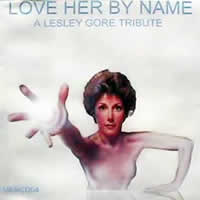Love Her By Name - a Lesley Gore tribute
- title
Love Her By Name
- label
Room-Filling Sounds
- format
- various artists CD
 In the mid-sixties, American top 40 music was nearly made by the same kinds of kids that listened to it. The songwriters-for-hire in New York City, the top record producers on both coasts, the A&R hustlers, the most powerful DJs, even many of the studio musicians- they were all the age of college students. The pop music industry had never had a population so close in social standing to its audience, and it's never had one since.
In the mid-sixties, American top 40 music was nearly made by the same kinds of kids that listened to it. The songwriters-for-hire in New York City, the top record producers on both coasts, the A&R hustlers, the most powerful DJs, even many of the studio musicians- they were all the age of college students. The pop music industry had never had a population so close in social standing to its audience, and it's never had one since.
1963 was the top of the roller-coaster. The charts and radio waves filled up with unsuspecting songs by the Beatles, the Beach Boys, and the girl groups that came from Phil Spector & the Brill Building. Independent record labels were more likely to produce a national hit then at any other time in American music. And the songs from those years have since become a permanent part of our culture's mental wallpaper, an ever-quotable echo of innocence from the innocent years of baby boomers.
The undisputed Queen of Teen from 1963 to '65 was Lesley Gore. She was, as the song says, just seventeen- the waspy daughter of a nice suburban family that emigrated from Russia. She got her break after she performed at a wedding, and started sitting in on her cousin's regular club gig. Spotted by a representative of Mercury records, she was sent to the label's new, hip A&R guy, Quincy Jones. Jones & Gore sat down and listened to a giant pile of songwriter demo records. They chose "It's My Party" for Lesley to record, with Jones producing. Her first single topped charts all over the country by that summer of '63.
Most female teen idols were plucked off New Jersey lawns in a similar manner. Most of them were also groomed to make the kind of teen music that pleased parents. They were stiff performers, and only marginally talented as singers. Lesley was a giant on the pop scene because she did the impossible: she didn't stink.
Supported by a studio echo just thick enough for rebel teens yet just thin enough for classy parents, Lesley and her double-tracked backup singers sailed amidst crisp orchestral production and the cream of the country's writing and arranging talent. By 1967, Gore had racked up eight top twenty hits. And so it's only natural that scores of not-quite-famouses from every part of the music world would emulate her.
And emulate her they did. Every solo girl after the teen market (Connie Francis, Shelley Fabares, Skeeter Davis, Jackie DeShannon, Joanie Somers, Petula Clark, Patty Duke and on and on) took a crack at the Lesley Gore style. Country singers as big as Tammy Wynette showed off her influence. Rock & roll bands told producers that they wanted her sound. Those who needed album filler considered covering her songs. Those who were just starting in the music business copied her. Those who were falling out of popularity tried to inject a touch of her style into their own.
"Love Her By Name: A Lesley Gore Tribute" is a cdr compilation of Lesley Gore's songs performed by other artists. And even if the title does contain the dreaded word "tribute", it doesn't stink any more than Lesley herself. The majority of the performances are contemporary with Gore's release of the song, which helps considerably. However the real credit must go to the Lesley Gore email list, which assisted one list member in its creation. It seems their obsessive drive to see every musician in the world as a potential Lesley-phile has turned up enough recordings that it was actually possible to pick 30 good ones.
The tracks are in rough chronological order (chronologically by Lesley's recording date, anyhow) and feature obscurities that range in style from girl group to garage rock, punk-disco, and near-musak. Bad girls like the Shangri-Las & Reparata & the Delrons add a smudge of R&B dirt to Lesley's smart white capris. You'll find Bernadette Peters, Joey Heatherton, and Claudine Longet before their careers were marred by the respective tribulations of the Love Boat, feathered hair, and shotgun wounds. Rock acts like Los Shakers and easy listening ones like the Four King Cousins sprinkle the compilation just enough to keep things novel. Even the contemporary acts you would expect to botch things up (Rasputina, Julie of Bikini Kill) are represented by surprisingly high-quality cuts. Only the last two tracks (versions of Gore songs from the late 70s and early 80s) fail to maintain an interest musical as well as historical.
Lucky for you & me, music is more than a backdrop to made-for-cable bio pics. So if you can get out from under your memories of rotten oldies radio and drippy nostalgic soundtracks, a more variegated cultural jungle than 60s pop is tough to find. There were gawky Brooklyn teens badly imitating Cole Porter, con-artists ejected from the army swindling songs for their neighbor's kid sister, hordes of short-lived fads to keep up with, leering twenty-nine-year-olds trying to steal each other's glory, and squares of all sorts trying to elbow in on the action. And that was before the drugs showed up (in the world at large) and things *really* got weird.